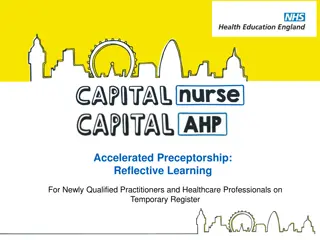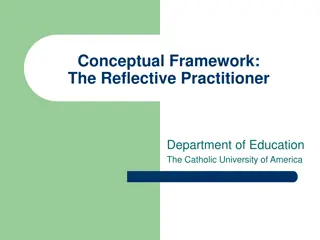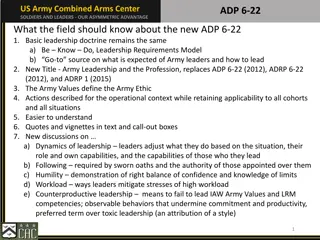Understanding Reflective Leadership: Learning and Application
Reflective leadership emphasizes the importance of combining learning with thoughtful reflection. It involves active consideration of beliefs and knowledge for continual growth. Traits like open-mindedness, responsibility, and whole-heartedness play key roles in effective reflection. Through experiential learning and professional practice reflections, leaders enhance self-awareness, understand others better, and align personal values with organizational goals. This comprehensive guide explores the essence of reflective leadership, offering insights on self-reflection, learning cycles, and practical application in various settings.
Download Presentation

Please find below an Image/Link to download the presentation.
The content on the website is provided AS IS for your information and personal use only. It may not be sold, licensed, or shared on other websites without obtaining consent from the author. Download presentation by click this link. If you encounter any issues during the download, it is possible that the publisher has removed the file from their server.
E N D
Presentation Transcript
Reflective Leadership Learning without reflection is a waste. Reflection without learning is dangerous. Confucius
What will we be talking about? What is reflection 3 Traits for reflective thinking Reflection as a means of learning The reflective practitioner Reflective leadership How to reflect Time to Reflect Q&A
Defining Reflection John Dewey (1933) described reflection as active, persistent, and careful consideration of any belief or supposed form of knowledge in the light of the grounds that support it and the further conclusions to which it tends, constitutes reflective thought It is a conscious and voluntary It is a conscious and voluntary effort to establish belief upon a firm basis of effort to establish belief upon a firm basis of reasons reasons (p. 9).
3 Necessary Traits for Reflective 3 Necessary Traits for Reflective Thinking Thinking Open Mindedness Responsibility Whole-heartedness (Dewey, 1933)
Reflection as a means of learning Experiential learning - learning through experience Learning from experiences requires reflection. The Experiential Learning Cycle: (Kolb, D. 1984)
Reflection for professional practice Donald Schon introduced two important categories for the process for reflecting as a practitioner. Reflection Reflection- -in in- -action action (interactive) Not a spectator In the action Reflection Reflection- -on on- -action action (retroactive) Reflecting on an outcome of a situation, the means that were used to manipulate the situation, and finally, on the reflection-in-action that took place (Tannebaum, R., Hall, A., & Deaton, 2013).
Reflective Leadership Learning to be present, aware, and attentive to ourselves and others. It takes Self-Reflection Areas for self Areas for self- -reflection reflection Personal ambitions, passions, intentions, goals Individual and organizational values Personality types Thinking styles Emotional Intelligence Reflective learning
Benefits to being a reflective leader The ability to develop personally and professionally on your own Continuous growth and improvement Life-long learning
What could be drawbacks to not being a reflective leader? Without reflection, it is easy to repeat past mistakes or fail to repeat approaches that were effective in previous situations (Sullivan, L. G. and Wiessner, C. A., 2010)
How to Reflect? Schedule time to reflect during your workday Focus equally on the negatives and the positives Experiment with reflecting
Leadership Statement or Philosophy Create a leadership statement or leadership philosophy for yourself http://www.managingamericans.com/BlogFeed/Leadership- Teambuilding/Crafting-Your-Own-Personal-Leadership- Philosophy.htm Be forward-thinking when writing What do you want to be when you grow up? Reflect and review it often Update the statement or philosophy as you grow and learn more Use it to guide you Wear it, own it, live it
Time to Reflect COVID-19 Reflect on the decisions you made in the spring and how they affected behaviors and actions. How did that reflection help you decide how you would approach fall?
References Dewey, J. (1933). How we think: A restatement of the relation of reflective thinking to the educative process. Revised edition, Boston: D. C.: Heath and Co. Horton-Deutsch, S. (2013). Thinking it through: The path to reflective leadership. American Nurse Today, 8(2). Retrieved from American Nurse Today. Schon, D. (1994). Postscript (from Italian edition of Reflective Practitioner). Planning Theory, 12, 1-18. Sullivan, L.G. and Wiessner, C.A., (2010). Learning to be reflective leaders: A case study from the NCCHC Hispanic Leadership Fellows Program. New Directions for Community Colleges, 149, 41-50. doi:10.1002/cc.394























